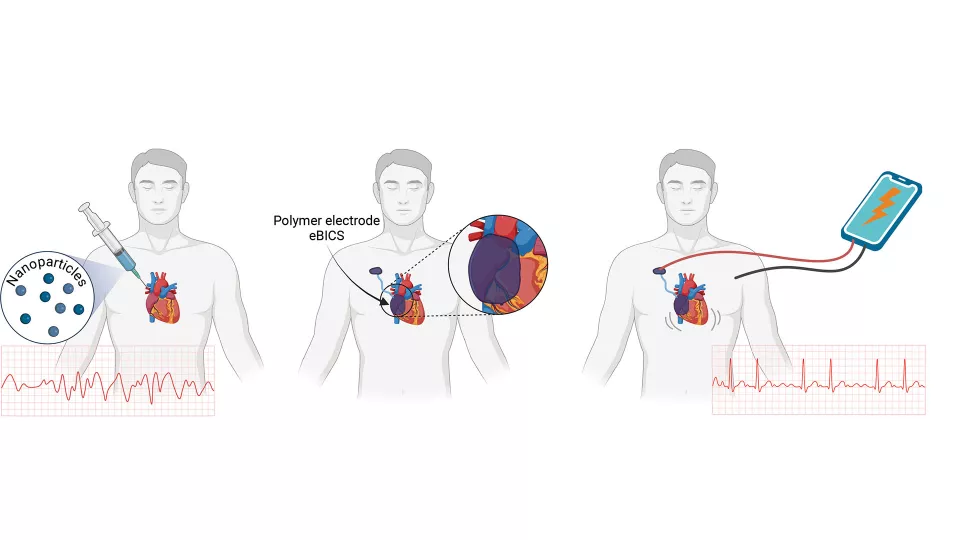Injectable Cardiac Stimulator Corrects Heart Arrhythmia in Emergency Situations
|
By HospiMedica International staff writers Posted on 29 Aug 2024 |

Arrhythmia, a condition characterized by irregular heartbeats, occurs when the heart's electrical signals are disrupted, causing it to beat too quickly, slowly, or unevenly. While medications are commonly used to manage arrhythmia, some procedures can directly alter the heart's rhythm, such as the use of defibrillators or the surgical implantation of pacemakers. However, such interventions can be particularly challenging to implement in remote or conflict areas where access to such medical devices is limited. Now, research on animals has demonstrated a groundbreaking approach: the injection of a nanoparticle solution around the heart that forms a temporary, self-assembling heart stimulator. This device can correct arrhythmias in emergencies through an external power source and then naturally disintegrates after its use, as detailed in a publication in Nature Communications.
Nanoparticles are minuscule, allowing them to be administered via an ultra-thin needle. In a collaborative effort led by researchers at Lund University (Lund, Sweden), these nanoparticles were shown to form a conductive polymer structure around the heart upon contact with tissue. This structure seamlessly integrates with cardiac cells, supports ECG monitoring, regulates heartbeat, and corrects arrhythmic events. The close contact between the polymer and heart tissue ensures that the stimulator functions efficiently with minimal power, which can be supplied by portable devices such as a mobile phone. By connecting a cable from the phone to the injection site near the heart, the phone can power the electrode.
The research team plans to develop a mobile app that would allow individuals to control the arrhythmia until professional medical help can be accessed. Initial tests have been conducted on small animal models like zebrafish and chicken embryos, adhering to the 3R principle to minimize the use of mammalian subjects in scientific research. With promising results from these preliminary stages, the researchers aim to advance to testing on larger animals, such as pigs, to pave the way for potential human application.
"We have developed an injectable heart stimulator for emergency situations, which consists of a syringe loaded with a solution of nanoparticles," said Roger Olsson, Professor of Chemical Biology and Therapeutics at Lund University and Professor of Medicinal Chemistry at the University of Gothenburg.
"The method is minimally invasive. Moreover, the heart stimulator spontaneously degrades and is excreted from the body after treatment, so it does not need to be surgically removed," added Martin Hjort, Associate Researcher in Chemical Biology and Therapeutics at Lund University.
Related Links:
Lund University
Latest Critical Care News
- Novel Intrabronchial Method Delivers Cell Therapies in Critically Ill Patients on External Lung Support
- Generative AI Technology Detects Heart Disease Earlier Than Conventional Methods
- Wearable Technology Predicts Cardiovascular Risk by Continuously Monitoring Heart Rate Recovery
- Wearable Health Monitoring Device Measures Gases Emitted from and Absorbed by Skin
- Groundbreaking Technology Rapidly Detects Airborne Influenza Viruses
- Handheld Device Could Transform Heart Disease Screening
- Flexible Semi-Autonomous Robot Could Deliver Medicine Inside Body

- Neurorestorative Treatment Strategies Hold Promise for Most Severe Forms of Epilepsy
- Gene Discovery Could Help Grow New Heart Arteries
- Study Discovers Invisible Transmission of Common Hospital-Associated Infection
- Non-Invasive Neuro-Ophthalmology Techniques Could Detect Brain Tumors Earlier
- Mass Manufactured Nanoparticles to Deliver Cancer Drugs Directly to Tumors
- World’s Smallest Pacemaker Fits Inside Syringe Tip

- AI-Powered, Internet-Connected Medical Devices to Revolutionize Healthcare, Finds Study
- Starfish-Inspired Wearable Tech Enables Smarter Heart Monitoring
- AI Eye Scans Could Help Identify Heart Disease and Stroke Risk
Channels
Surgical Techniques
view channel
Intravascular Imaging for Guiding Stent Implantation Ensures Safer Stenting Procedures
Patients diagnosed with coronary artery disease, which is caused by plaque accumulation within the arteries leading to chest pain, shortness of breath, and potential heart attacks, frequently undergo percutaneous... Read more
World's First AI Surgical Guidance Platform Allows Surgeons to Measure Success in Real-Time
Surgeons have always faced challenges in measuring their progress toward surgical goals during procedures. Traditionally, obtaining measurements required stepping out of the sterile environment to perform... Read morePatient Care
view channel
Portable Biosensor Platform to Reduce Hospital-Acquired Infections
Approximately 4 million patients in the European Union acquire healthcare-associated infections (HAIs) or nosocomial infections each year, with around 37,000 deaths directly resulting from these infections,... Read moreFirst-Of-Its-Kind Portable Germicidal Light Technology Disinfects High-Touch Clinical Surfaces in Seconds
Reducing healthcare-acquired infections (HAIs) remains a pressing issue within global healthcare systems. In the United States alone, 1.7 million patients contract HAIs annually, leading to approximately... Read more
Surgical Capacity Optimization Solution Helps Hospitals Boost OR Utilization
An innovative solution has the capability to transform surgical capacity utilization by targeting the root cause of surgical block time inefficiencies. Fujitsu Limited’s (Tokyo, Japan) Surgical Capacity... Read more
Game-Changing Innovation in Surgical Instrument Sterilization Significantly Improves OR Throughput
A groundbreaking innovation enables hospitals to significantly improve instrument processing time and throughput in operating rooms (ORs) and sterile processing departments. Turbett Surgical, Inc.... Read moreHealth IT
view channel
Printable Molecule-Selective Nanoparticles Enable Mass Production of Wearable Biosensors
The future of medicine is likely to focus on the personalization of healthcare—understanding exactly what an individual requires and delivering the appropriate combination of nutrients, metabolites, and... Read more
Smartwatches Could Detect Congestive Heart Failure
Diagnosing congestive heart failure (CHF) typically requires expensive and time-consuming imaging techniques like echocardiography, also known as cardiac ultrasound. Previously, detecting CHF by analyzing... Read moreBusiness
view channel
Expanded Collaboration to Transform OR Technology Through AI and Automation
The expansion of an existing collaboration between three leading companies aims to develop artificial intelligence (AI)-driven solutions for smart operating rooms with sophisticated monitoring and automation.... Read more

















